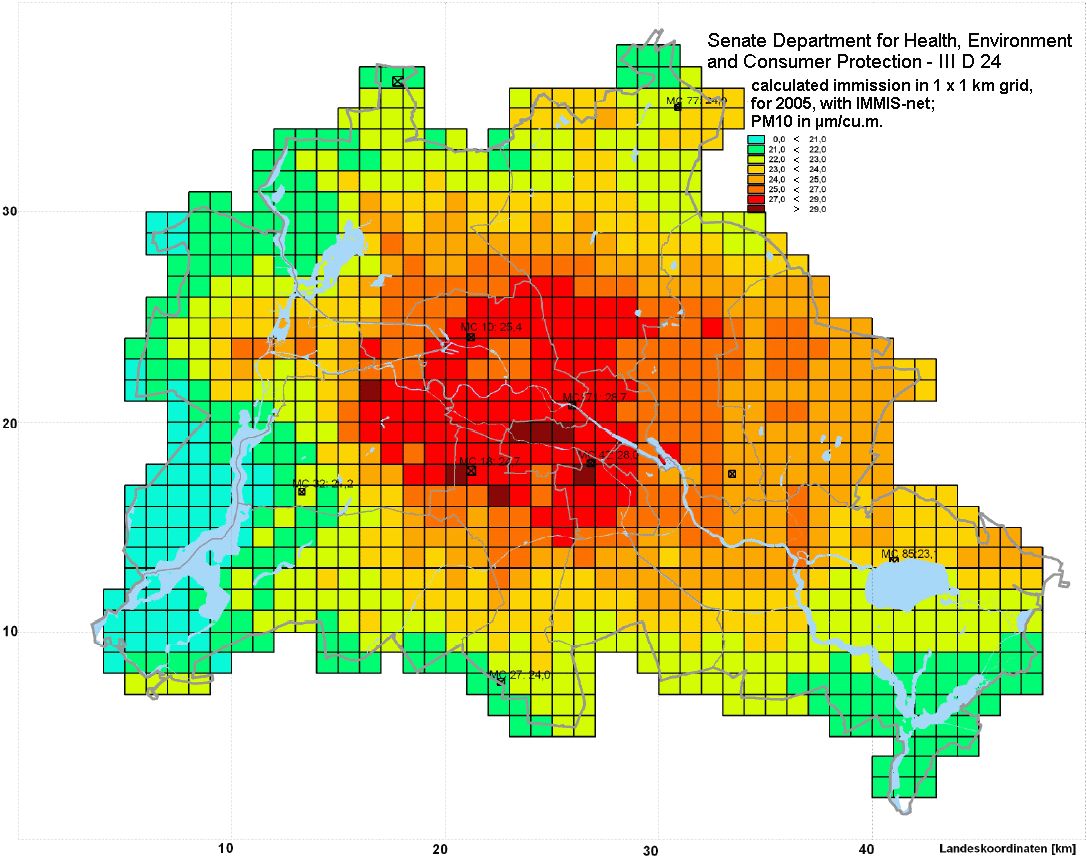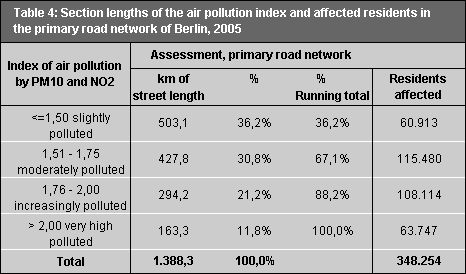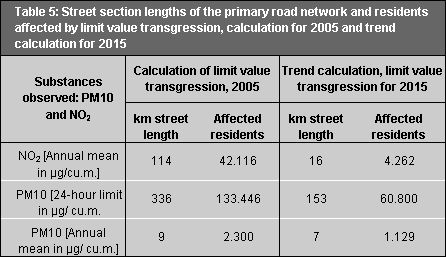The approach used to calculate the number of residents affected by limit value transgressions was also taken from the noise mapping procedure (see Maps 07.05 Strategic Noise Maps, 2008 Edition)). The number of residents in the flats facing the street front was counted. The number of citizens affected by limit value transgressions thus ascertained represents a rather conservative estimate, because the pollutants spread everywhere, so that increased concentrations can also occur outside highly polluted canyon streets.
Calculated trends through 2015 for the substances PM10 and nitrogen dioxide (NO2)
With regard to permanent compliance with limit values for clean-air maintenance, the calculation of trend scenarios is of great importance. It permits the future development of large-scale and local air pollution to be assessed, and also enables an evaluation of whether additional measures beyond those already initiated are necessary to achieve a reduction in air pollution. The immission values for 2005, which are also the basis for the calculation of the air pollution indices, constitute the point of departure. The resulting trend scenario takes into account the reduction on the emissions side at the trend point in time 2015, for Europe and Germany, and also at the local level in Berlin. Thus, progress due to the implementation of European regulations for pollutant emissions by plants, power stations and motor vehicles is incorporated, as are agricultural emissions of particulate matter.
The exhaust emissions from motor vehicle traffic is likely to decrease, due to the gradual removal of older vehicles with high pollutant emissions; by 2015, this will amount to almost 40% for nitrogen oxides and more than 50% for particulates. However, the particulate produced by the abrasion of the road, tyres and brakes, as well as by the stirring up of street dust by the wind will increase insignificantly, due to increased driving activity.
In sum, the result for Berlin will be a drop in NOx emissions by more than 21 % and in PM10 emissions by about 7 % by 2015, in comparison with 2005 levels.
In order to comply with the 24 hr limit value for particulates everywhere, a considerably greater reduction in concentrations will however be required. Nonetheless, such an improvement cannot be expected without additional reduction measures, either for the local nor for the imported portion of particulate pollution, so that even in 2015, it can be assumed that some 153 km of primary road network, with some 61,000 affected residents will show transgressions of the 24 hr value for PM10 (cf. Table 5). Such additional measures must be taken in Berlin, at the national and at the European levels, to reduce both shares further.
A similar result can be predicted for the development of nitrogen dioxide pollution. The measures of the trend scenario already initiated will cause the concentration on the major streets to drop considerably by 2015, which will also reduce the number of streets with limit value transgressions and the residents affected by about 86 %. However, additional measures, mainly in Berlin, will be required to relieve the remaining almost 16 km of streets and the 4,300 (check) people affected who live on them.

![Fig. 9: 90.41% value of particulate concentration PM10 [µg/cu.m.] in 2002 at the measurement stations of the BLUME measurement network.](/imgscaler/MWumuhdXUchBKzfodXxjVnyroBx_MmNa4HdX3RdOmn4/ropen/L3N5czExLXByb2QvdW13ZWx0YXRsYXMvX2Fzc2V0cy9sdWZ0L3N0cmFzc2VudmVya2Voci1lbWlzc2lvbmVuLXVuZC1pbW1pc3Npb25lbi9kcy1hL2VuLWFiYmlsZHVuZ2VuL2VhYTMxMV8wOV9ncm9zcy5naWY.jpg?ts=1678391031)
![Fig. 10: 90.41% value of particulate concentration PM10 [µg/cu.m.] in 2005 at the measurement stations of the BLUME measurement network.](/imgscaler/_8Tm1N10ZeMX75QCa0jCKKwSCxUOGLENVaRjqE4gpmw/ropen/L3N5czExLXByb2QvdW13ZWx0YXRsYXMvX2Fzc2V0cy9sdWZ0L3N0cmFzc2VudmVya2Voci1lbWlzc2lvbmVuLXVuZC1pbW1pc3Npb25lbi9kcy1hL2VuLWFiYmlsZHVuZ2VuL2VhYTMxMV8xMF9ncm9zcy5naWY.jpg?ts=1678391033)
![Fig. 11: 90.41% value of particulate concentration PM10 [µg/cu.m.] in 2007 at the measurement stations of the BLUME measurement network.](/imgscaler/zaJNYHfBos5YCxowb5m4bnO-AXwk_rSE9OEd0kh5Xeg/ropen/L3N5czExLXByb2QvdW13ZWx0YXRsYXMvX2Fzc2V0cy9sdWZ0L3N0cmFzc2VudmVya2Voci1lbWlzc2lvbmVuLXVuZC1pbW1pc3Npb25lbi9kcy1hL2VuLWFiYmlsZHVuZ2VuL2VhYTMxMV8xMV9ncm9zcy5naWY.jpg?ts=1678391053)


